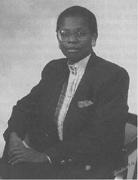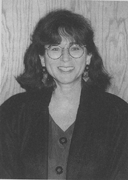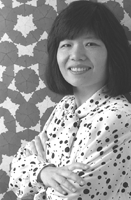On the Outside Looking In: Women in Mathematics
March 8, 1998

"No matter how good you actually are," says NIST mathematician Fern Hunt, "there is definitely somebody who can run rings around you. . . . This and the fact that mathematics is a field a lot of people have trouble with causes a great deal of anxiety both within and outside the profession. I think we should minimize it by trying to look for the talent people have, rather than dismissing them for the talent they lack."
Book Review
Women in Mathematics: The Addition of Difference. By Claudia Henrion, Indiana University Press, Bloomington and Indianapolis, 1997, 293 + xxxi pages, $16.95.
Claudia Henrion, a mathematician (currently a visiting professor at Dartmouth College, where she teaches courses in mathematics, education, and women's studies), set out to write the sort of book that, by conveying a variety of success stories, would encourage other women to go into mathematics. But about halfway through the process of writing her book--the recently published Women in Mathematics: The Addition of Difference--she realized that the positive and even inspiring stories told by the 11 successful female mathematicians she had interviewed were only a part of the story. To give an accurate picture of women in mathematics, she writes in her introduction, she felt that she needed to consider two questions that were not adequately addressed by her initial vision of the book:
"First, why is it that women continue to be significantly underrepresented in mathematics, particularly at the highest levels? And second, why is it that even the most successful women in mathematics, those who have already made it by standard measures of success, often continue to feel (to varying degrees) like outsiders in the mathematics community?"
In the course of considering graduate programs herself, Henrion writes, she was advised by the chair of a mathematics department that had a large, prestigious program to look elsewhere: "You're too normal; you wouldn't fit in here." Most of the women Henrion interviewed reported variations on that experience, at various times in their careers. In the words of Judy Roitman, a professor of mathematics at the University of Kansas:
"I think I tend to be a little pushy and strident because I had to be in graduate school to be heard. So I am generally not a very good colleague. I don't think I socialize correctly or work well with other people. Basically, I'm too sensitive to not being taken seriously, and I tend to simply fade away and give up."
On the basis of her interview with Lenore Blum, then deputy director of the Mathematical Sciences Research Institute at Berkeley, Henrion writes that "often it takes many years for women to recognize the ways they have internalized . . . negative images of women in mathematics, further undermining their confidence in themselves." Karen Uhlenbeck of the University of Texas at Austin, with a MacArthur fellowship and membership in the National Academy of Sciences to her credit, is "not able to transform myself completely into the model of the successful mathematician because at some point it seemed like it was so hopeless that I just resigned myself to being on the outside looking in."
Forced to confront issues not only of gender but also of race were the two African American women interviewed for the book--Fern Hunt, a senior researcher at the National Institute of Standards and Technology, and the late Vivienne Malone-Hayes. Their stories have several common threads: the strong influence of the racial composition of the universities at which each did doctoral work and later taught; the importance of religion as a sustaining force throughout their lives; and, in addition to a love of mathematics, the desire to teach, "to convey the excitement of a life of the mind, open doors of opportunity that would otherwise be closed to minority students," as the motivating factor in their decisions to study mathematics.
Malone-Hayes, the first black professor at Baylor University (which, citing racial barriers in 1966, had refused to admit her to its doctoral program), was profoundly isolated during her years at Baylor--to the extent of being told by the department chair, when she asked about teaching summer classes, "I haven't even offered those to the white male faculty yet."
The devastating comments and experiences notwithstanding, this is not an overwhelmingly negative book. Reading the women's stories is enjoyable and inspiring; talent and drive, and a love of mathematics, are givens for these women, and the obstacles each one overcame to become a mathematician in some sense add to the stories, given the known successful outcomes. But what about the women--very much in the thoughts of Henrion and her subjects--who had the talent and inclination but haven't been able or willing to persist in a field in which they would always be outsiders?
Henrion's subjects go into detail about the things that got them through. Children and husbands (also mathematicians in several cases) are central to their stories, both as sources of support and as logistical problems to be solved. Various successful child-bearing models are presented: have children toward the end of graduate school (Blum and Fan Chung Graham, now a member of the faculty at the University of Pennsylvania) or have children after college and defer graduate study (the path taken by Joan Birman of Barnard College-Columbia University, who received her PhD at the age of 41). This is not to say that all was smooth--Chung's decision to forego maternity leave and have her second child during her four weeks' vacation (during which she wrote a paper) was based in part on her feeling that pregnancies and children were to be downplayed, almost hidden from employers.

Research mathematician Lenore Blum's search for a supportive community led her to political activism: "I've never had good established institutions, so I just created them." Among the institutions is the Association for Women in Mathematics, of which she was a founder and an early president (1975-78).
Birman reported a relatively smooth path to a PhD and eventually a position as a respected research mathematician. "I guess that if I could see any solution to the non-participation of women in mathematics," she told Henrion, "it would be, first of all, if women were able to think about going back to mathematics at a later point, and if there was a practical way for them to do this, . . . and if the whole community was ready to accept this as another option-all of these things would help."
But the reality is that many women find themselves having children at about the same time they come up for tenure. "Yes," said Birman, "and the men are working like lunatics on their mathematics, and the women, they see this choice, and if you give it a little less effort, your research is dead."
Critical to the successful outcome of each woman's story are supportive colleagues in the mathematics community. What emerges clearly is the intense effort that has to go into the creation of such groups for women, while men, it seems, are largely free to get on with doing mathematics. As Henrion says in her first chapter, "Rugged Individualism and the Mathematical Marlboro Man" (in which she discredits the myth that all good mathematics is the work of loners):
"It is so much a part of the normal course of events for men to be tied into the mathematical community that it is easy for them to take it for granted, not even recognizing the way in which community is invisibly operating behind the scenes: in helping them to get jobs, in brainstorming sessions with colleagues about ideas, in the exchange of news about recent theorems in bars or bathrooms, in the suggestion of each other's names as speakers or journal editors. As one mathematician pointed out, 'How do people get picked to be editors of journals? Well, there's an awful lot of contacts and friendships, no question about it. Women miss out in that. They don't have those connections.'"
During her graduate studies, at New York University, Fern Hunt found support in the critical mass of women among the NYU graduate students and, especially, in an organization of black graduate students called the New York Mathematics Society. For Lenore Blum, a difficult early experience at Berkeley transformed her, Henrion writes, "from being naive about the politics for women in academia, to taking an active part in helping women navigate the difficult terrain of such a traditionally male field as mathematics." It was at that time that Blum "began to appreciate the necessity of forming communities; she formed strong ties with other women in science, including Judy Roitman, and from 1975 to 1978 she served as the third president of the then new Association for Women in Mathematics.

Fan Chung Graham (whose ideas about a course she has developed at the University of Pennsylvania are described "Can a Mathematician Be All Things to All People") was born in Taiwan and received an undergraduate degree in mathematics from Taiwan University, where it happened that ten of the 30 students in her class were women. Continuing friendships with the women from that group who, like Chung, did their graduate work in the U.S., has been a source of support to Chung, as has the vast network of researchers (which includes her husband, Ron Graham) with whom she has collaborated on research papers.
Who is the audience for this book? Certainly women who are interested in studying mathematics and women already in mathematics who have become discouraged will find much to interest and help them. Faculty who teach such women would put it to good use. But it would be a loss to relegate the book to a shelf for occasional reference to an interested student or beginning mathematician.
Everyone in the mathematics community in which each of Henrion's subjects struggled so hard to find a place could benefit by a thoughtful reading. Some of the widely held perceptions of the way mathematics is done--the loner stereotype, the notion that it is a young man's field--can have needless adverse effects on any mathematician. As Henrion concludes:
"If there is one lesson that is clear from the history of mathematics, it is that questioning even the assumptions that seem most obvious and fundamental can lead to profound new ideas and visions. If we want to think hard about ways to be more inclusive of non-traditional groups, it is critical to reexamine all aspects of the discipline."

